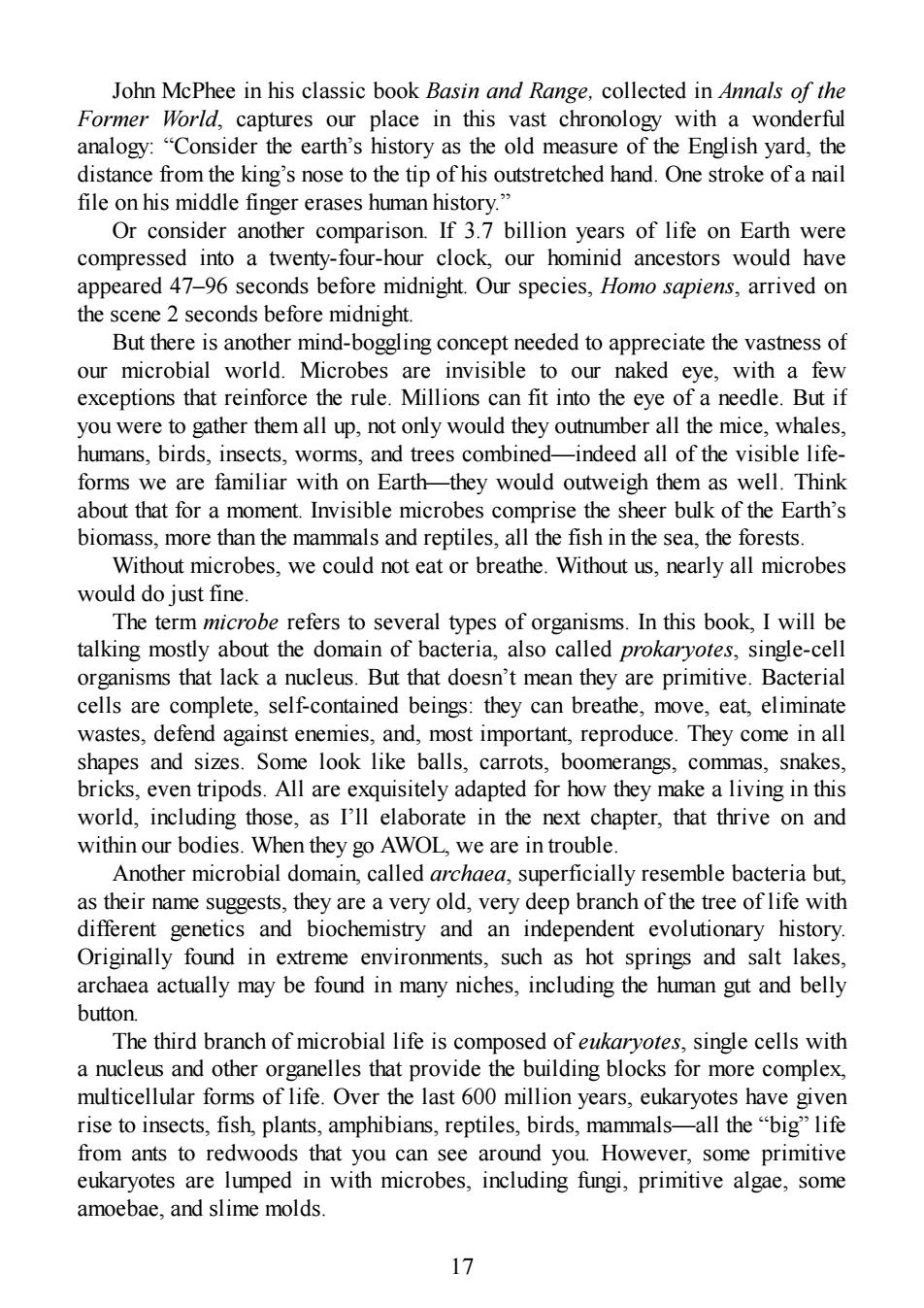正在加载图片...

John McPhee in his classic book Basin and Range,collected in Annals of the Former World,captures our place in this vast chronology with a wonderful analogy:"Consider the earth's history as the old measure of the English yard,the distance from the king's nose to the tip of his outstretched hand.One stroke of a nail file on his middle finger erases human history." Or consider another comparison.If 3.7 billion years of life on Earth were compressed into a twenty-four-hour clock,our hominid ancestors would have appeared 47-96 seconds before midnight.Our species,Homo sapiens,arrived on the scene 2 seconds before midnight. But there is another mind-boggling concept needed to appreciate the vastness of our microbial world.Microbes are invisible to our naked eye,with a few exceptions that reinforce the rule.Millions can fit into the eye of a needle.But if you were to gather them all up,not only would they outnumber all the mice,whales. humans,birds,insects,worms,and trees combined-indeed all of the visible life- forms we are familiar with on Earth-they would outweigh them as well.Think about that for a moment.Invisible microbes comprise the sheer bulk of the Earth's biomass,more than the mammals and reptiles,all the fish in the sea,the forests. Without microbes,we could not eat or breathe.Without us,nearly all microbes would do just fine The term microbe refers to several types of organisms.In this book,I will be talking mostly about the domain of bacteria,also called prokaryotes,single-cell organisms that lack a nucleus.But that doesn't mean they are primitive.Bacterial cells are complete,self-contained beings:they can breathe,move,eat,eliminate wastes,defend against enemies,and,most important,reproduce.They come in all shapes and sizes.Some look like balls,carrots,boomerangs,commas,snakes, bricks,even tripods.All are exquisitely adapted for how they make a living in this world,including those,as I'll elaborate in the next chapter,that thrive on and within our bodies.When they go AWOL.we are in trouble. Another microbial domain,called archaea,superficially resemble bacteria but, as their name suggests,they are a very old,very deep branch of the tree of life with different genetics and biochemistry and an independent evolutionary history. Originally found in extreme environments,such as hot springs and salt lakes, archaea actually may be found in many niches,including the human gut and belly button The third branch of microbial life is composed of eukaryotes,single cells with a nucleus and other organelles that provide the building blocks for more complex, multicellular forms of life.Over the last 600 million years,eukaryotes have given rise to insects,fish,plants,amphibians,reptiles,birds,mammals-all the"big"life from ants to redwoods that you can see around you.However,some primitive eukaryotes are lumped in with microbes,including fungi,primitive algae,some amoebae,and slime molds. 17 John McPhee in his classic book Basin and Range, collected in Annals of the Former World, captures our place in this vast chronology with a wonderful analogy: “Consider the earth’s history as the old measure of the English yard, the distance from the king’s nose to the tip of his outstretched hand. One stroke of a nail file on his middle finger erases human history.” Or consider another comparison. If 3.7 billion years of life on Earth were compressed into a twenty-four-hour clock, our hominid ancestors would have appeared 47–96 seconds before midnight. Our species, Homo sapiens, arrived on the scene 2 seconds before midnight. But there is another mind-boggling concept needed to appreciate the vastness of our microbial world. Microbes are invisible to our naked eye, with a few exceptions that reinforce the rule. Millions can fit into the eye of a needle. But if you were to gather them all up, not only would they outnumber all the mice, whales, humans, birds, insects, worms, and trees combined—indeed all of the visible lifeforms we are familiar with on Earth—they would outweigh them as well. Think about that for a moment. Invisible microbes comprise the sheer bulk of the Earth’s biomass, more than the mammals and reptiles, all the fish in the sea, the forests. Without microbes, we could not eat or breathe. Without us, nearly all microbes would do just fine. The term microbe refers to several types of organisms. In this book, I will be talking mostly about the domain of bacteria, also called prokaryotes, single-cell organisms that lack a nucleus. But that doesn’t mean they are primitive. Bacterial cells are complete, self-contained beings: they can breathe, move, eat, eliminate wastes, defend against enemies, and, most important, reproduce. They come in all shapes and sizes. Some look like balls, carrots, boomerangs, commas, snakes, bricks, even tripods. All are exquisitely adapted for how they make a living in this world, including those, as I’ll elaborate in the next chapter, that thrive on and within our bodies. When they go AWOL, we are in trouble. Another microbial domain, called archaea, superficially resemble bacteria but, as their name suggests, they are a very old, very deep branch of the tree of life with different genetics and biochemistry and an independent evolutionary history. Originally found in extreme environments, such as hot springs and salt lakes, archaea actually may be found in many niches, including the human gut and belly button. The third branch of microbial life is composed of eukaryotes, single cells with a nucleus and other organelles that provide the building blocks for more complex, multicellular forms of life. Over the last 600 million years, eukaryotes have given rise to insects, fish, plants, amphibians, reptiles, birds, mammals—all the “big” life from ants to redwoods that you can see around you. However, some primitive eukaryotes are lumped in with microbes, including fungi, primitive algae, some amoebae, and slime molds. 17